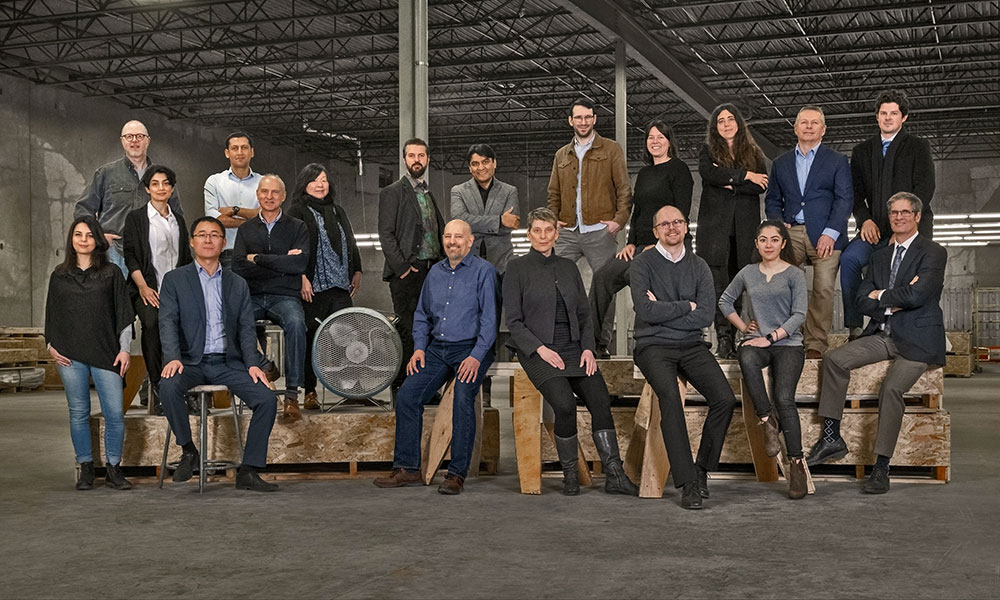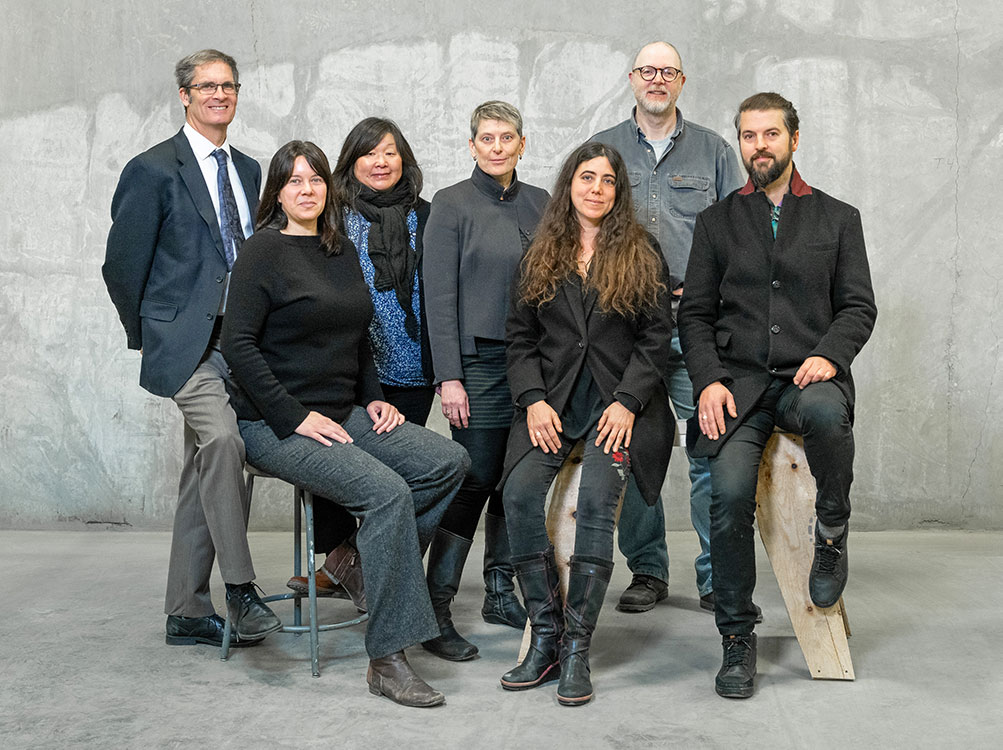
IMAGINE AN OPEN, SERENE EXPANSE OF LAND edged with Ponderosa pines, whispery dry grass and blue sky the colour of a robin’s egg. Imagine ideas growing there that have the potential to change your life, your community, region, country and the world. Ideas that contain new knowledge exchanged between a university and its community partners to answer challenges arising during an unprecedented period of change in human history.
This is UBC’s Innovation Precinct, a vision that’s taking shape with the dedication and imagination of researchers, students and staff at UBC’s Okanagan campus, alongside key community partners.
Green Field, Blue Sky
The term ‘greenfield’ is often used to describe projects across multiple sectors and with unobstructed, wide-open opportunities to build, create or invent new solutions. In the context of the site at UBC Okanagan (UBCO), the greenfield opportunity lies within 60 acres of land earmarked for the Innovation Precinct. In lay terms, it’s not a ‘renovation’ but a new build — one with an open horizon that calls for innovative thinking when it comes to how the university can chart its course to 2040 and beyond.
But the Innovation Precinct is more than blue-sky thinking; it’s part of a deliberate strategy to create a ‘collision zone,’ where for-profits and not-for-profits can collaborate with the university in a way that creates mutually-beneficial relationships. The ultimate goal is to nurture socio-economic opportunities that directly benefit the Central Okanagan region and catalyze innovative collaborations that have far-reaching impact.

A look into the future of UBC Okanagan, including the Innovation Precinct.
“We want to create a zone that allows us to help partners solve thorny problems,” explains Phil Barker, vice-principal, UBCO Research and Innovation. “This will expand the ability of our research teams to take on significant real-world challenges, while creating training opportunities and new knowledge.”
The Innovation Precinct is intentionally designed to not only support knowledge exchange and translation but, more urgently, to create societal change. For a modern university whose core vision is about “inspiring people, ideas and actions for a better world,” it seems apt that UBC Okanagan’s new precinct has societal benefits embedded into its strategy.
“There’s a shift in attitude,” says Barker. “Our approach is, how can we help? What is the problem we need to solve, and how can we deploy resources in ways that are going to be meaningful?”
A focus on community anchors the Precinct’s goal of scaling regional solutions that are home-grown in the BC Interior to have national and global impact. Barker notes that these close partnerships will “elevate the ability of the region to compete in the new economy.
“The creation of this campus was driven by the local community with the intention to create a site where students could be trained and acquire expert skill sets that have the potential to contribute to the economic development of the region.”
“We want to create a zone that allows us to help partners solve thorny problems.”
In contrast to urban centres, where universities are often hemmed in by physical constraints, the Innovation Precinct presents an opportunity most universities simply do not have access to. Barker emphasizes that this is a benefit for UBC as a whole: “You’ve got to force the issue, right? You have to create an environment that brings people together in new ways and allows conversations to happen and relationships to flourish that wouldn’t otherwise.
“For me, it’s what’s really exciting about being here. We’re largely in control of our destiny. And you cannot say that of many campuses.”
Wicked Problems
In 1973, American societal design theorists Horst Rittel and Melvin Webber coined the term “wicked problem” in reference to the complexities and challenges of planning and addressing social policy problems. Wicked problems are complex, difficult to solve, and are characterized by unique, interrelated disciplines and interdependencies that, by their nature, require collaborative problem-solving behaviours.
“The way I look at it, the potential is not interdisciplinary for the sake of being interdisciplinary, it’s because we have to solve wicked problems,” asserts Rehan Sadiq, executive associate dean of the UBCO School of Engineering. “Wicked problems don’t have disciplines and wicked problems don’t have one single and unique solution.”
For Bryce Traister, dean of the Faculty of Creative and Critical Studies, the multi-disciplinary, multi-faculty approach opens up more possibilities for cross-campus collaboration in the Innovation Precinct. “I have colleagues in Vancouver who are as excited about this new sort of creative and scientific sandbox here in the Okanagan as I am.”
Unconventional Collaborators

Executive associate dean, professors, staff and students from the School of Engineering.

Dean, Faculty of Creative and Critical Studies with professors from the Department of Creative Studies.
One of the new ‘sandbox’ spaces is 1540 Innovation Drive, the first building in the Innovation Precinct portfolio under development. What was essentially an empty, unheated space will soon be home to a vibrant mix of industry partners, researchers and students. That mix is deliberate. Graduate students and faculty from the School of Engineering and the Faculty of Creative and Critical Studies will be co-located alongside industrial partners as opportunities for exciting new research collaborations emerge. It’s anticipated that this ‘collision’ will produce new thinking that, in turn, takes on some of these wicked problems in an innovative way.
“The challenge of the space,” posits Traister, “is to see whether or not having the humanist, the creative and the engineer in the same room right from the start will actually lead to better design choices.”
Traister believes spaces such as 1540 Innovation Drive are ideal environments for programs such as the interdisciplinary professional master’s program he is creating with Sadiq called Design, Innovation, Creativity, and Entrepreneurship (DICE). Still in development, the degree program would see cohorts of 20 to 30 students tackle a particular problem collaboratively during their studies.
“It’s about real-world problems, real-world issues, and developing our capacity to solve those problems,” says Traister. In his view, it’s about developing “new things, inventions, and narratives in an academic space that allows you to think about your problem in an inspiring setting that supports contemplative and experimental work.”

Fine Arts student Aiden de Vin in her studio. Dedicated MFA studio space will be located next to engineering labs in the new building.
Admittedly it’s an experiment, but one that Barker relishes: “We’re going to be co-locating visual artists with engineers and creating shared spaces that will, I think, facilitate some exciting interactions. It’s hard to predict where it’s going to go, but it’s going to be a fun experiment.”
Sadiq views the 1540 Innovation building space as an opportunity for students to “convert intellectual outcomes into something that is beneficial for society but also has market value.” He hopes the new space will open up “opportunities that will lead to entrepreneurship in material engineering and manufacturing sectors.” The key, suggests Sadiq, is to create an environment “where students are asking questions, and they’re not afraid of failing quickly.”
Failing fast — a term often used in entrepreneurial environments, particularly start-ups — where iteration and testing is crucial to the strength of an idea and determining whether it is an investment worthy of time and resources. It forces the best ideas to the forefront, where they can be improved upon. There’s no stigma of failure attached to the process, since iterative learning allows something of tangible value to emerge.
It’s a fearless ethos that fits the Innovation Precinct as a whole. Or as Traister notes: “Since we are, in certain respects, a start-up as an academic community, we actually have the permission to fail.”
Creative Connections
Lukas Bichler, associate director, Research and Industry Partnerships with the School of Engineering, describes the new campus development as “an adventure.” In many respects, this is what the Innovation Precinct is asking its inhabitants to embark upon.
As the first building to go up on Innovation Drive and one of the first to test out the theory of this ‘adventure,’ 1540 is a space that is influenced by an intentional interdisciplinary design ethos. As Bichler explains, “Space and the surroundings play a significant role for research because it provides us with context and sometimes even direction of where our research is headed.”
Along with Bichler, Denise Kenney, department head and associate professor, Faculty of Creative and Critical Studies, was a key member of the consultation committee for the 1540 building. She too sees it as an ideal opportunity for new thinking to emerge: “Informal and formal encounters and relationships amongst researchers from the creative arts, engineering and industry that result in creative and practical solutions can only benefit all of us.”
One of the unique aspects of the facility, says Bichler, is that “students, professors and industry partners will be in one building.” He believes the resulting social connections and relationships are likely to form some very interesting out-of-the-box thinking. In other words, the day-to-day spontaneous ‘water-cooler’ conversations could be where discoveries begin.
“So there’s going to be about 80 engineering graduate students, maybe about 10 fine arts students, all interacting together, all being together with industrial partners talking, having coffee, having lunches together and that will spark some unique, innovative ideas.”
What was a 2,267-square-metre warehouse building at the north end of the campus will soon become a kind of ‘living laboratory’ and ‘creative engineering hub’ for the region. The building will foster a kind of innovation that Bichler defines as the creation of “new knowledge, new processes, new technologies and a new way of looking at things.”
The expectation and hope is that the interdisciplinary connections and knowledge fostered in this new space can be a model for the rest of the Innovation Precinct as it gets developed.
People and Place
In addition to new student housing and research space for a young and growing campus, the Innovation Precinct is also envisioned to hold other collaborative sites, including the Digital Learning Factory. These buildings won’t merely add square footage to UBC Okanagan’s campus; according to Barker, they will shift the paradigm away from a traditional university campus. “We’re proposing a different model. We’re saying, ‘What’s the community problem?’ And then, ‘Let’s investigate how we’re going to solve this.’”
“We’re proposing a different model. We’re saying, ‘What’s the community problem?’ And then, ‘Let’s investigate how we’re going to solve this.’”
The vision for the Innovation Precinct is bold. The greenfield opportunity isn’t about development for development’s sake — it’s about contributing to a world that desperately needs solutions to its ‘wicked’ problems,’ while understanding those solutions start right in our own backyard.
“What we want the Innovation Precinct to do is twofold,” explains Barker. “First, we want to leverage UBC resources to contribute to solutions for our business and non-profit partners, and second, we want to elevate the ability of the region to succeed.”
In the landscape of Canada’s knowledge economy, the future of UBC Okanagan has an exciting potential to be a significant contributor. But Traister underscores that it isn’t really the new spaces and new stuff that will make it happen — it’s the people.
When asked what he thinks the world will say 20 years from now about the Innovation Precinct, Barker doesn’t hesitate. “I would want people in Ottawa, Toronto, Montreal, and Winnipeg to be saying that’s how you do it. That’s how you create a zone in which a university can partner effectively and nimbly with partners for the short term and long term. One that solves problems and creates new knowledge. That is what I hope we can leave as a legacy.”